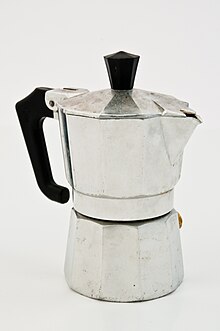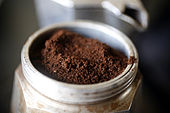
A cappuccino is an espresso-based coffee drink that is traditionally prepared with steamed milk including a layer of milk foam.

Espresso is a coffee-brewing method in which a small amount of nearly boiling water is forced under pressure through finely ground coffee beans.
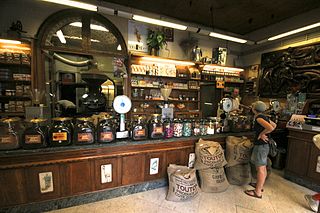
Italians are well known for their special attention to the preparation, the selection of the blends, and the use of accessories when creating many types of coffees. Many of the types of coffee preparation known today also have their roots here. The main coffee port in Italy is Trieste where there is also a lot of coffee processing industry. Italian coffee consumption, often espresso, is highest in the city of Trieste, with an average of 1500 cups of coffee per person per year. That is about twice as much as is usually drunk in Italy.
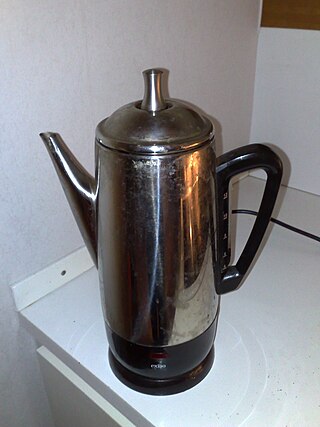
A coffee percolator is a type of pot used for the brewing of coffee by continually cycling the boiling or nearly boiling brew through the grounds using gravity until the required strength is reached. The grounds are held in a perforated metal filter basket.

An espresso machine brews coffee by forcing pressurized water near boiling point through a "puck" of ground coffee and a filter in order to produce a thick, concentrated coffee called espresso. Multiple machine designs have been created to produce espresso. Several machines share some common elements, such as a grouphead and a portafilter. An espresso machine may also have a steam wand which is used to steam and froth liquids for coffee drinks such as cappuccino and caffè latte.
Darcy's law is an equation that describes the flow of a fluid through a porous medium. The law was formulated by Henry Darcy based on results of experiments on the flow of water through beds of sand, forming the basis of hydrogeology, a branch of earth sciences. It is analogous to Ohm's law in electrostatics, linearly relating the volume flow rate of the fluid to the hydraulic head difference via the hydraulic conductivity. In fact, the Darcy's law is a special case of the Stokes equation for the momentum flux, in turn deriving from the momentum Navier-Stokes equation.

Gaggia is an Italian manufacturer of coffee machines, especially espresso machine, in addition to small kitchen appliances. The company is owned by Saeco.

Lungo is a coffee beverage made by using an espresso machine to make an Italian-style coffee – short black with more water, resulting in a larger coffee, a lungo.

The Neapolitan flip coffee pot is a drip brew coffeemaker for the stove top that was very popular in Italy until the 20th century. Unlike a moka express, a napoletana does not use the pressure of steam to force the water through the coffee, relying instead on gravity.

La Marzocco, founded in 1927, Florence, by Giuseppe and Bruno Bambi, is an Italian company specializing in high-end espresso coffee machines. It is based in Scarperia, with branch offices worldwide.

Rancilio is an espresso machine manufacturer, founded in 1927 by Roberto Rancilio in Parabiago, Italy.
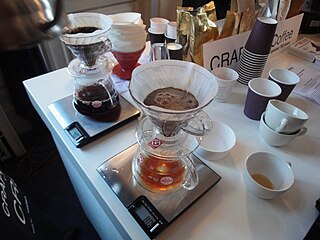
Coffee preparation is the process of turning coffee beans into liquid coffee. While the particular steps vary with the type of coffee and with the raw materials, the process includes four basic steps: raw coffee beans must be roasted, the roasted coffee beans must then be ground, and the ground coffee must then be mixed with hot or cold water for a specific time (brewed), the liquid coffee extraction must be separated from the used grounds, and finally, if desired, the extracted coffee is combined with other elements of the desired beverage, such as sweeteners, dairy products, dairy alternatives, or toppings.
Alfonso Bialetti was an Italian engineer who became famous for introducing the Moka Express coffeemaker. Designed in 1933, the coffee pot has been a style icon since the 1950s. While many variations of the Moka have been developed, including the Bialetti cow-printed Mukka Express, the original remains a time-honoured classic. Bialetti was also the founder of Bialetti Industries, now an Italian kitchen-ware company. The Bialetti brand is now owned by Bradshaw International, which manufactures and sells Bialetti brand kitchen-ware.

Caffè americano, also known as americano or American, is a type of coffee drink prepared by diluting an espresso shot with hot water at a 1:3 to 1:4 ratio, resulting in a drink that retains the complex flavors of espresso, but in a lighter way. Its strength varies with the number of shots of espresso and the amount of water added. The name is also spelled with varying capitalization and use of diacritics: e.g., "café americano".

Bialetti is an Italian brand of coffee machines, cookware and small kitchen appliances founded by Alfonso Bialetti. The brand is owned by Bialetti Industries.
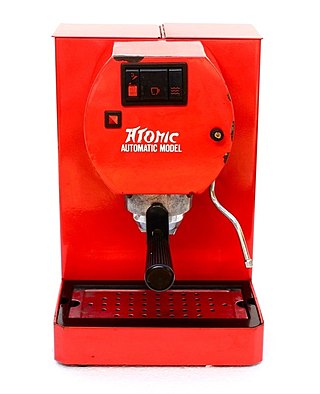
Coffee machines sold under the trademark "Atomic coffee machine" existed both as stove-top device, and electrical versions.
Caffè crema refers to two different coffee drinks:

A coffeemaker, coffee maker or coffee machine is a cooking appliance used to brew coffee. While there are many different types of coffeemakers, the two most common brewing principles use gravity or pressure to move hot water through coffee grounds. In the most common devices, coffee grounds are placed into a paper or metal filter inside a funnel, which is set over a glass or ceramic coffee pot, a cooking pot in the kettle family. Cold water is poured into a separate chamber, which is then boiled and directed into the funnel and allowed to drip through the grounds under gravity. This is also called automatic drip-brew. Coffee makers that use pressure to force water through the coffee grounds are called espresso makers, and they produce espresso coffee.

ISSpresso was the first espresso coffee machine designed for use in space, produced for the International Space Station by Argotec and Lavazza in a public-private partnership with the Italian Space Agency (ASI). ISSpresso was one of nine experiments selected by the Italian Space Agency for the Futura mission. It was installed on the space station between 2015 and 2017, when it was returned to Earth.
